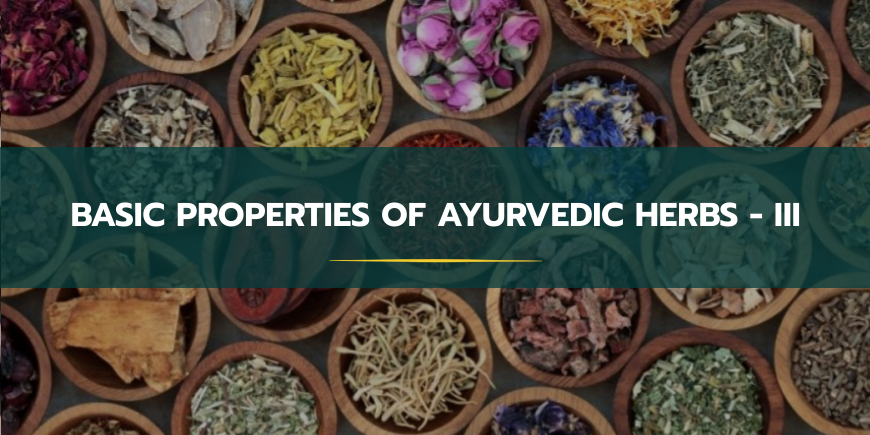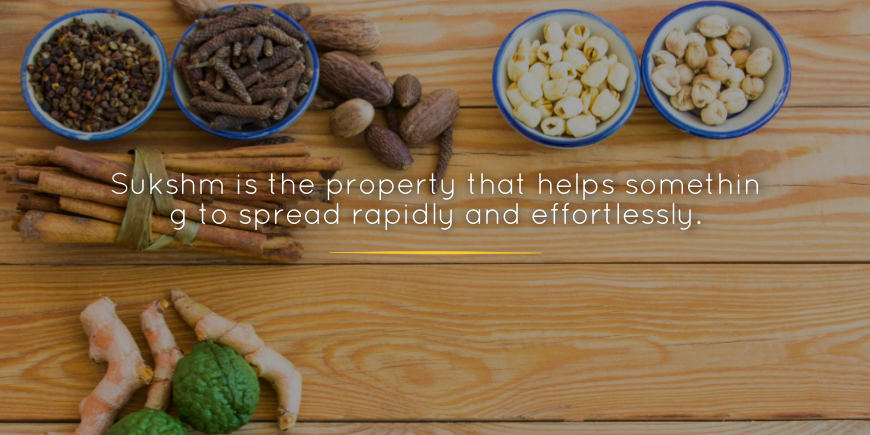
In the previous blogs, we have discussed the first 12 properties of Dravya (substance). In this final blog about GurvadiGuna, let us discuss the remaining 8 properties.
Vishad (Clear)
According to Master Hemadri, vishad is a property that dissolves any fibrous bands in a liquid. VishadGuna causes lightness in the body. All harsh compounds like acids, bases, salts are vishad.
For example, an acid that helps to clear a choked drain is highly vishad. Our blood contains a special compound called Anticoagulant factor protein S. This factor helps to prevent the blood from clotting. Protein S is an ideal example of vishad property.
Insects like leeches have a special compound called hirudin that prevents blood coagulation. Mosquito saliva contains a compound called anophelines, 100 times more effective than the clinical anti-blood coagulants available today.
Vishad is an important property not only in the blood. It is found everywhere in nature. The water helps in multiple metabolic functions because it is not vicious. It is the best solvent because it is “vishad”.
Pichchal (Slimy)
Pichchal means viscous or slimy. This property envelopes binds and moisturizes all body tissues.
Pichchalis the contrasting property to vishad. And obviously, it is the factor that leads to blood coagulation, a life-preserving function. The tissue fluid contains fat-soluble vitamins because of its fat-preserving slimy nature. Lymph has a certain degree of sliminess.
The protective fluids which surround critical organs, such as the heart (pericardium), the lungs (pleura), or the brain (cerebrospinal fluid), are slimy. They ensure moisture, nutrition, and protection of these vital organs. They are better shock absorbers than a clear fluid, due to their viscosity and thick texture.
PichchalGuna supports excretion or any bulk transportation inside the body. It lubricates the channel surface and ensures smooth movement. Herbs like Isabgol are effective in constipation because they produce excess mucus. This slimy mucus moistens the fecal matter and helps in relieving constipation.
Pichchal/slimy covering around the nerves protects them from rapid deterioration. When this slimy protective layer is lost due to rapid cell oxidation, the nerve signals dissipate and become weak. This nervous deterioration may lead to severe neurological disorders like Alzheimer’s disease, dementia, etc.
Pichchal is a life-preserving property in its balanced state.
Summary
Vishadatva (clarity) is a property opposite to Pichchalatva (sliminess). Harsh compounds like acids, bases, and salts create clarity and reduce viscosity. The digestive juices, bile, and blood have this property of clarity. Sliminess forms protective coats around vital organs. The mucus lines all the body cells and protects them from dryness or inflammation.
Shlakshan (Smooth)
Shlakshna or smooth is another important property that combines with other properties to promote metabolic functions. One beautiful example of Shlakshna is the lotus leaf. The lotus leaf is smooth with a water-proof coating. It stays dry and decay-free even when submerged in water.
Smoothness may appear to be integral with sliminess, or moisture. However, smoothness is an independent property. For example, bones are smooth without any slimy layer or moisture.
The smoothness may be permanent or induced. In most cases, the bones are permanently smooth. However, they have rough edges that provide attachment support for other structures like tendons, ligaments, etc.
The intestines have millions of strands like structures. So, the intestinal lining is not smooth. But the intestinal mucus lining has a smoothening effect on the serrated villi-covered surface. Constant mucus secretion maintains this smoothness.
Smoothness combines with other properties (clarity (protective salty secretions), moisture, oiliness, etc) and prevents pathogen accumulation on the skin surface.
Shlakshan comes before Khar (rough) as it is superior to roughness, regarding natural life-sustaining functions.
Khar (Rough)
Roughness or Kharatvahas abrasive property or power to cause erosion.
Roughness appears to be harmful to the body, esp. when you think about dryness in skin, lips, etc. Dryness in the large intestines leads to constipation. Dryness may be the cause of roughness in most cases. However, roughness is an independent property.
Roughness brings balance to excessive smoothness. For example, the muscles, etc can easily attach themselves to rugged edges of bones. The rough surface of teeth helps to chew food properly.
Roughness is also important physiologically. Rough fibers present in the food help to clean the intestines. The skin cells gradually die and become rough. This rough skin surface is immune to pathogens.
Summary
The contrasting pair of Slakshan(smooth) and Khar(rough) sustain the body together. Smoothness is integral to ease of movement inside the body. The permanent smoothness of bones and the transient mucus-induced smoothness of the intestines, both help the body. On the other hand, the khar (rough) outer layer of the skin, the epidermis efficiently protects the body due to roughness.
Sukshm (Subtle)
According to Master Hemadri, Sukshm is the property that helps something to spread rapidly and effortlessly. A fine substance can easily cross physical barriers and spread to a large area. The fragrance is an ideal example of a Sukshm substance. It spreads effortlessly and quickly to a large area.
This is an important property for a rapid dynamic system like our body. Subtility is the property that helps –
- Oxygen dissolves in the blood and reaches all parts of the body
- hormones to spread throughout the body within seconds
- digestive enzymes to penetrate the food
- electromagnetic signals to bolt through the body
- alcohol to spread fast and affect the nervous system
- poisons and allergic reactions to cause fatal conditions
According to Ayurveda, substances like alcohol, hemp, marijuana, etc. are Sukshma. This is the reason they create an immediate impact on the body. Any herb with this quality will produce an immediate effect on the mind and the body.

Sthul (Bulky/gross)
Sthul is the opposing property to Sukshma. Grossness helps to balance the subtlety. Subtility promotes rapid movement and may cause hyperactivity. Grossness or bulkiness is the property that slows down or obstructs hyperactivity.
For example, the grossness of the blood-brain barrier protects many fast-spreading toxins from entering the brain.
Subtility is a quality of space element. The space element is a constituent factor for vata dosha. Excess subtility results in vata imbalance. Fats cause bulkiness and eliminate excess vata.
All anabolic processes create bulkiness in the body. For example, the making of bones, muscles, or body fat increases bulkiness. Whereas, osteoporosis happens when the bones lose bulkiness (calcium content) and become sublime!
However, many abnormal conditions like obesity or tumor formation are also related to bulkiness. Therefore, balance is the key.
Summary
Suksham (subtle) substances can easily penetrate most of the metabolic barriers and rapidly spread throughout the body. The essential process of oxygen diffusion throughout the body happens due to subtility. Alternatively, Sthul substances (gross) prevent metabolic hyperactivity and prevent the indiscriminate spread of chemicals throughout the body. For example, the blood-brain barrier protects the brain from multiple toxins.
Sandra (Solid)
Solidity or Sandrata is the foundation of all physical existence. However, few things are permanently solid in our body, like bones, tendons, ligaments, etc. all tissues transition from one form to the other. For example, Ayurveda says that meda (fat tissue) upgrades to form the bony tissue. The bony tissue advances to the higher dhatu (tissue) – the marrows. So, solidity is present as a property than a fixed structure.
Bulkiness is very close to solidity. They may appear to be the same. But a dense liquid also can be bulky, for example, mercury is bulkier than a cotton bud. So, solidity may or may not contain bulkiness.
Imbalanced solidity leads to condensation or accumulation in the wrong places. We can reconsider the example of obesity, tumors, or fatty knots in the body, concerning solidity.
Besides, all properties like solidity have degrees. For example, a tumor may be very soft (lipoma) or hard (malignant tumors).
Dravya (Fluid)
Dravatva or fluidity is the basis of the entire metabolism. After all, our body contains more than 60% liquid. According to Master Hemadri, this property is responsible for flowy movement. A fluid takes the shape of its container and spreads effortlessly to occupy all available space.
Dravatva or fluidity is different from liquidity. Therefore, this property covers liquids and gases too.
Fluidity is the basis of transportation in the body. The gaseous exchange of oxygen and carbon-di-oxide in the blood, the diffusion of food and oxygen in the body cells, cellular excretion, movement of food in the alimentary canal, almost all metabolic functions depend on fluidity.
All enzymes and hormones work in the fluid medium. Without fluids, there will be no metabolic activity.
Summary
Sandra (solid) substances frame the body structure and provide stability, balance, and support for locomotion. Major anabolic activities depend on solidity for growth and development. On the other hand, fluidity is the basis for transportation and change inside the body.
How Ayurveda uses these properties
In this blog, we discussed the properties as per Ayurveda. However, these properties are the basis of Vedic physics. They apply to everything saguna(tangible) in this universe.
These properties are as fundamental to Ayurveda as basic chemistry is to modern medicine. They define the metabolic functions, as well as herbal qualities. For example, the process of digestion depends on ushma or heat, respiration depends on fluidity, subtility, softness, and lightness. Denseness, hardness, or solidity in the lungs hinders normal breathing.
However, these twenty Gurvadi properties have no fixed structure or place in the body. But they work as transitional factors in our dynamic physiology. The tissues shift from solidity to liquidity, from softness to hardness, and vice versa.
Herbs also contain these properties. These properties are the basis of their mode of action on the body. For example, turmeric isushna(hot), ruksha (dry), and laghu (light). These properties are opposite to kapha dosha (cold, unctuous, and heavy). Therefore, turmeric is very effective in all kapha disorders.
These properties are the foundation of the Ayurvedic diet, lifestyle, and treatment. For example, a kapha dominant person should consume more warming herbs like garlic, ginger, black pepper to balance the coldness of kapha dosha. An obese person should exercise (mobility) to shake up the stable fat storage.
Take Away
These pairs of contrasting properties act like two legs. They balance each other as the entire metabolism moves forward. Gurvadi properties are present everywhere and govern all physical entities.
Ayurveda uses these properties to define body anatomy and physiology. These properties form the basis of dietary/lifestyle recommendations and Ayurvedic treatment.
I hope that this information brings a fundamental understanding of Ayurveda.
Ready to unlock the incredible potential of Ayurveda? Enroll in our Ayurveda Certification Course and immerse yourself in a world of natural healing and well-being. Gain deep insights into the principles and techniques of Ayurveda, and learn how to harness its power to promote optimal health and vitality. Take the first step towards a fulfilling career or personal growth by joining us today!
Responses